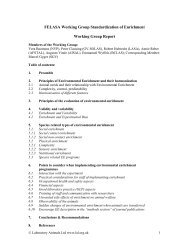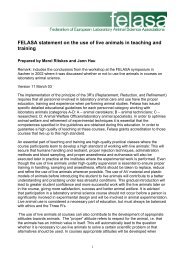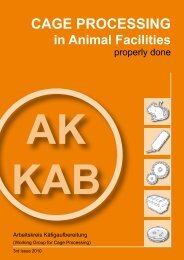CAGE PROCESSING in Animal Facilities - Felasa
CAGE PROCESSING in Animal Facilities - Felasa
CAGE PROCESSING in Animal Facilities - Felasa
- No tags were found...
Create successful ePaper yourself
Turn your PDF publications into a flip-book with our unique Google optimized e-Paper software.
7.3.1 Wash<strong>in</strong>gThe wash<strong>in</strong>g performance is assessed accord<strong>in</strong>g to DIN 10511. The water bottles are contam<strong>in</strong>ated directlywith test soil<strong>in</strong>g. No extra test strips are needed. The relevant test number of items as well as the number ofthe wash cycles are <strong>in</strong>dicated <strong>in</strong> table 7-2. The assessment is done on a visual basis.7.3.1.1 Produc<strong>in</strong>g the test soil<strong>in</strong>gThe test soil<strong>in</strong>g for contam<strong>in</strong>ation is made of reconstituted skimmed milk. For produc<strong>in</strong>g 100 ml of reconstitutedskimmed milk, 10 g skimmed milk powder is mixed with 100 ml distilled water. The mixture must be stirredvigorously before be<strong>in</strong>g steam sterilised for 5 m<strong>in</strong>utes at 121 °C. For extra good adhesion, 13 g celluloseshould be added before sterilis<strong>in</strong>g.Table 7-3Chemicalspray-dried skimmed milk powdercellulose (microcrystall<strong>in</strong>e for th<strong>in</strong>-layer chromatography)Source of supplypharmacyFLUKA chemicals catalogue, CH-Buchs7.3.1.2 Apply<strong>in</strong>g the test soil<strong>in</strong>gA water bottle should be half-filled with test soil<strong>in</strong>g and be emptied by giv<strong>in</strong>g it a rotation <strong>in</strong> a tilted position, sothe entire <strong>in</strong>side of the bottle is wet with test soil<strong>in</strong>g. For wett<strong>in</strong>g the bottle rim, it is recommended to dip the rim1 cm deep <strong>in</strong>to the test soil<strong>in</strong>g. The dry<strong>in</strong>g process takes 2 hours altogether with the bottles be<strong>in</strong>g first placedupside down <strong>in</strong> a bottle crate and turned over after an hour.The assessment is done visually and differentiates between clean and soiled bottles (please refer to figuresbelow). Acceptance criteria: All test bottles must be visually clean.Figure 7-7 Contam<strong>in</strong>ated test bottle Figure 7-8 Still soiled test bottle Figure 7-9 Clean test bottle7.3.2 Decontam<strong>in</strong>ationWater bottles do not get soiled and contam<strong>in</strong>ated as much as cages and other items for process<strong>in</strong>g do (e.g.with excrement, urea, etc.). Therefore, the decontam<strong>in</strong>ation of water bottles is not equally relevant. Although itis generally possible to check water bottles for decontam<strong>in</strong>ation, it needs a very complex procedure. The reasonis, that there are no standardisable test strips, and each bottle type would have to undergo an <strong>in</strong>dividualprocedure. It is therefore recommended by the work<strong>in</strong>g group to sterilise water bottles whenever a hygienicstandardisation of the process<strong>in</strong>g procedure for water bottles is required. This approach is also common practice.54Cage Process<strong>in</strong>g <strong>in</strong> <strong>Animal</strong> <strong>Facilities</strong> · 4th issue · 2013






